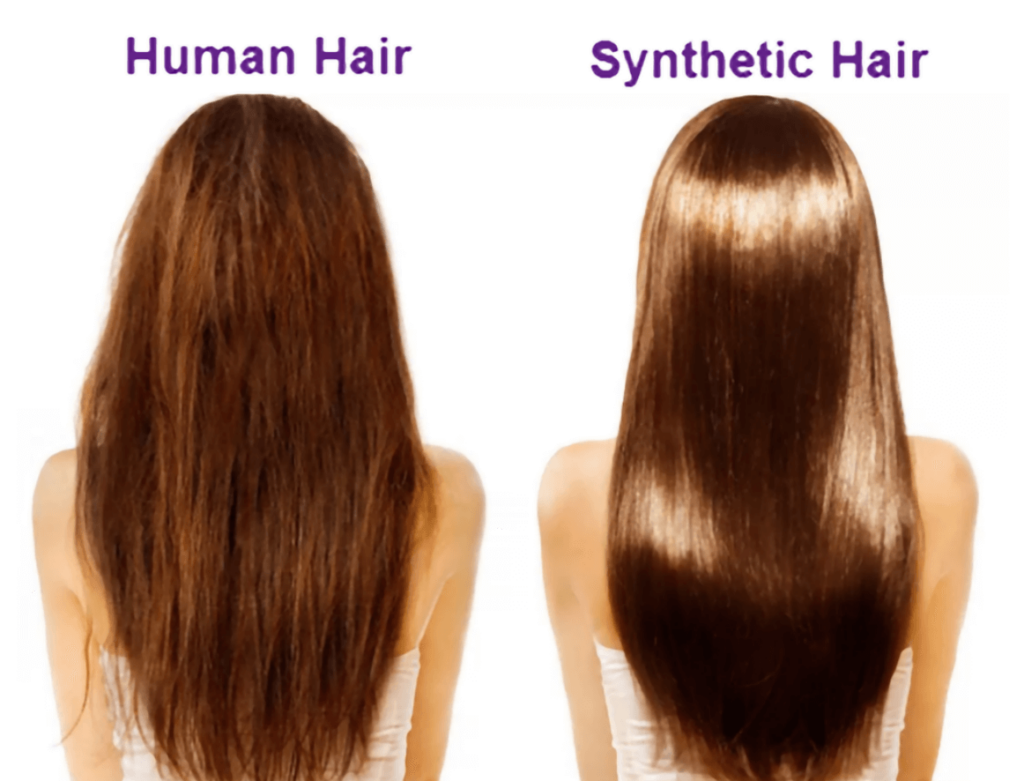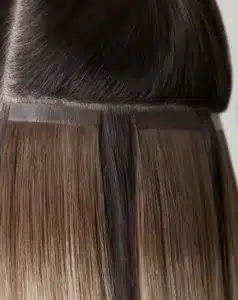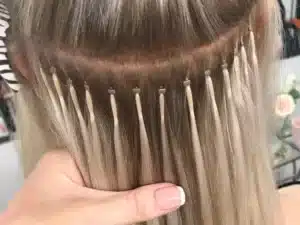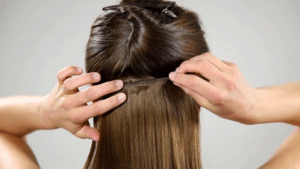Navigating the world of hair extensions? Wondering about the differences between synthetic and human hair? We’ve crafted a guide to illuminate the intricacies and aid your decision-making process.
Synthetic hair is made from man-made fibers designed to mimic real hair, often being more budget-friendly with varied styles, but can have a shorter lifespan. Human hair, sourced directly from donors, is renowned for its natural appearance, styling versatility, and longer durability, but it comes at a higher cost.
1

1
define synthetic hair?
Synthetic hair confuses teams because it looks perfect in the bag. The finish changes fast on real heads. I set expectations first.
Synthetic hair is fiber-based hair made from plastics engineered to mimic human hair. It ships pre-curled or straight. Most versions resist restyling, some “heat-friendly” lines allow low heat only.
What is synthetic hair made of
- Modacrylics (e.g., Kanekalon®): Soft feel, light weight, modest heat tolerance.
- PVC/Polyolefin (e.g., Toyokalon® families): Silky hand, lower heat tolerance.
- PET/Polyester blends: Stronger fiber, holds preset curl, can feel plastic when over-processed.
- Heat-friendly synthetics (HFS): Modified polymers rated for limited heat restyling.
Advantages of synthetic hair
- Price: Low entry cost for retail sets and fashion colors.
- Set memory: Curls hold in humidity without much effort.
- Speed: Ready-to-wear; no advanced finishing needed.
- Consistency: Factory-controlled diameter and color repeat easily.
Disadvantages of synthetic hair
- Heat limits: Many fibers deform or melt over ~120–160°C (250–320°F). Check manufacturer limits.
- Color limits: You cannot bleach. Toners rarely bond.
- Shine: Flash photography can read plastic shine, especially on dark shades.
- Longevity: 1–3 months of good wear in salon use; frizz and friction show early at nape.
- Static and tangling: Dry air and coats cause flyaways; friction builds at collars.
Quick reference table
| Fiber type | Heat tolerance* | Restyle ability | Typical lifespan | Notes |
|---|---|---|---|---|
| Modacrylic | Very low–low | No | 1–3 months | Light, soft hand |
| PVC/Polyolefin | Very low | No | 1–2 months | Silky but sensitive |
| PET/Poly blends | Low–medium | Some (factory) | 1–3 months | Can feel rigid |
| Heat-friendly synthetic | Low–medium | Limited, low heat only | 2–4 months | Move slowly with tools |
*Always confirm brand limits before styling. When unsure, avoid direct heat.

human hair materials?
Not all “human hair” is equal. Performance comes from raw material and processing. I choose the material first, the method second.
Human hair materials include general human hair, Remy, Virgin, and full cuticle single-donor hair. Each tier changes styling, color work, and lifespan.
Key categories
- General human hair: Mixed sources, variable cuticle. Often acid-washed and heavily silicone-coated. Looks good new; coating washes out over time.
- Remy hair: Collected root-to-tip, cuticles largely aligned. Less tangling, better response to heat and tone.
- Virgin hair: Human hair with no prior chemical color or perm. Often overlaps with Remy in practice.
- Full cuticle single-donor: Cuticles fully intact, aligned one direction, minimal processing. Highest integrity and repeat performance.
Advantages of human hair
- Realism: Light reflection matches natural hair. No plastic glare in flash.
- Heat styling: Safe at salon temps with protectant; holds curl and smooth finishes.
- Coloring: You can tone, lowlight, or gloss. Gentle lifts on premium grades.
- Longevity: 3–6 months for mid grades; 9–12 months for high Remy/Virgin; 12–24 months for full cuticle with proper care.
Disadvantages of human hair
- Price: Higher entry cost, especially for full cuticle single-donor.
- Care: Needs washing, conditioning, and proper product choices.
- Supply: True single-donor supply is limited; lead times apply.
Lifespan snapshot
| Grade | Styling freedom | Color freedom | Typical lifespan | Best fit |
|---|---|---|---|---|
| General human | Medium | Low–medium | 3–6 months | Entry installs |
| Remy | High | Medium | 6–12 months | Professional salons |
| Virgin | High | Medium–high | 9–12+ months | Premium services |
| Full cuticle | Very high | High | 12–24 months | Luxury salons/brands |
difference between human hair and synthetic hair?
People ask “synthetic hair vs human hair” as if price is the only variable. It is not. The differences touch camera, color, comfort, and cost per wear.
Human hair behaves like your client’s hair. Synthetic behaves like fabric with a set shape. Pick based on the use case, not just cost.
Side-by-side matrix
| Dimension | Human hair | Synthetic hair |
|---|---|---|
| Look under flash/4K | Natural reflection, multi-tonal | Risk of plastic shine |
| Heat styling | 160–210°C with protectant | Often limited or unsafe |
| Color work | Tone, gloss, lowlight | Not colorable (bleach unsafe) |
| Longevity | 3–24 months by grade | 1–3 months |
| Movement | Fluid, hair-like | Set memory, less fluid |
| Humidity response | Frizz manageable with care | Shape holds, but frizz shows at rub points |
| Feel to touch | Hair-like, softens with care | Can feel silky-plastic or rigid |
| Cost per wear | Lower over time | Higher over time despite low entry |
| Sustainability | Reusable, fewer replacements | Frequent replacement, more waste |
Cost per wear example (illustrative)
- Full cuticle set: $X upfront, reused across 4–6 move-ups → cents per wear drops fast.
- Synthetic set: Low upfront, replaced several times per season → cost per wear rises.
Client experience
Human hair blends into routine styling. Synthetic asks clients to change habits. In luxury service, friction costs you time and after-sales effort. That is why I push premium human hair for B2B.
what advantage does human hair have over synthetic hair?
Stylists need control. Human hair gives control. Control creates consistency. Consistency builds retention.
Human hair wins on realism, styling freedom, color control, longevity, and overall economics. For brands and salons, these gains become repeat business and fewer service issues.

Practical advantages
- Custom finish on demand: Curl, wave, smooth, or blowout to match the brief.
- Color match at pro level: Shadow root, micro-lowlight, gloss corrections before install.
- Service lifespan: Fewer replacements, fewer callbacks, better margins.
- Comfort: Softer feel, natural movement, less friction at collars.
Business advantages
- Brand reputation: Photos read premium. Clients post better content.
- Inventory efficiency: Fewer SKUs replaced; more sets refurbished and reused.
- Education simplicity: Teach standard haircare instead of restrictive synthetic rules.
- Sustainability: Less waste, easier to justify premium pricing.
When synthetic still makes sense
- Cosplay/fashion colors for single events.
- One-night volume where heat restyling is not required.
- Very humid venues where preset curl memory helps, with client fully informed.
How to tell if hair is synthetic or human?
You need fast, non-destructive checks at intake. You also need lab-like checks for high-value stock. I use a step ladder of tests.
You can tell with feel, friction, water behavior, controlled heat, and—if needed—microscope or burn analysis. Start safe, escalate only if required.
Tier 1: Quick, safe checks
- Friction slide: Pinch a few strands, slide fingers root → tip and tip → root. Human hair has cuticle drag tip → root; synthetic often feels the same both ways.
- Water soak: Human hair absorbs and sinks slowly, becomes heavier when wet. Many synthetics bead water and float longer.
- Sheen under mixed light: Under daylight + flash, human hair shows soft, varied reflection; synthetic can glare uniformly.
Tier 2: Controlled checks (salon)
- Low-heat pass: With protectant, test at ~140–160°C on a hidden strand. Human hair reshapes; many synthetics deform or stick. Only do this with caution.
- Tangle resilience: Brush through; human hair releases with product and water. Synthetic catches and kinks at bends.
Tier 3: Technical checks (backroom/lab)
- Microscope: Human hair shows overlapping cuticle scales; synthetic shows smooth extruded surface.
- Burn test (safety first): Tiny strand, well-ventilated, fire-safe area. Human hair chars and smells like burning protein; synthetic melts, balls, and smells like plastic. Use only if other methods fail and follow safety protocols.
Note: Suppliers can blend fibers. Combine tests for confidence.

How to care synthetic hair?
Synthetic needs gentle handling and low heat. Products matter. Storage matters more. Treat it like a delicate fabric.
Care focuses on cool water, mild cleansers, air dry, and anti-static control. Heat tools are risky unless the fiber is heat-friendly and you stay very low.
Wash routine
- Frequency: Every 8–12 wears or when product builds.
- Shampoo: Use fiber-safe or wig shampoo. Cool water only.
- Method: Swish, do not rub. Rinse in one direction.
- Conditioner: Use fiber conditioner. Avoid base/clip seams.
Dry and style
- Dry: Blot with microfiber. Air-dry on a hanger or stand. No wringing.
- Restyle: If heat-friendly, stay under the brand’s limit (often ≤160°C/320°F). Move slowly. Use a protective sleeve or comb-through method.
- Static control: Light silicone-free detangling spray; a tiny touch of leave-in on ends.
Daily handling
- Brush: Wide-tooth or wig brush from ends up.
- Clothing friction: Watch coats and scarves; add a small anti-friction dab on nape fibers.
- Storage: Cool, dark, breathable bag or box. Keep shape with net.
How to care human hair
Human hair wants what natural hair wants: cleansing, hydration, heat protection, and smart products. Bonds and bases need respect.
Care depends on format: clip-ins vs tapes/wefts/keratin. Keep roots clean, ends nourished, and chemicals off attachments.
Clip-ins
- Wash: Every 10–20 wears. Sulfate-free shampoo; condition mids–ends.
- Dry: Air-dry 80%, finish cool blow-dry.
- Style: ≤180°C/350°F with protectant. Pre-style sets to save time.
- Store: Dry, brushed, in hanger bag. No heavy oils at clips.
Semi-permanent (tapes, wefts, keratin)
- Scalp care: Wash 2–3× weekly. Aim water and shampoo between rows/bonds.
- Conditioning: Mids–ends only. Keep masks and oils off attachments.
- Drying: Dry roots fully after each wash.
- Styling: ≤180–200°C with protectant. Keep tools off bonds.
- Chelate: Weekly during swim/travel/hard water.
- Move-ups: Tapes 6–8 weeks; wefts 6–10 weeks; keratin remove/replace at 3–5 months.
Product rules
- Yes: Water-based leave-ins, heat protectant, light serums on ends.
- No: Heavy oils at scalp, aerosol sprays blasting attachments, high-alcohol products.

My opinion
I select material first, then method. For luxury salons and brands, full cuticle single-donor human hair gives the lowest cost per wear, the best finish on camera, and the fewest after-sales issues. Synthetic has a role for short events and bold colors, but it cannot replace human hair in premium work. My factory standard stays the same: ethical sourcing, gentle processing, and clean, repeatable quality for B2B partners.
FAQ
Which lasts longer, synthetic or human hair?
Human hair. Full cuticle can last 12–24 months with care; synthetic usually 1–3 months.
Can you curl synthetic hair?
Only if it is heat-friendly, and then at very low temps. Always check brand limits.
Does human hair tangle less than synthetic?
Yes, especially Remy and full cuticle grades. Proper care reduces friction further.
Can I color synthetic hair?
No. You cannot bleach it, and toners do not bond well. Choose pre-colored stock.
What is synthetic hair made of?
Plastic polymers like modacrylic, PVC, polyolefin, or PET; some are modified for low-heat styling.
Is Remy the same as full cuticle?
Not always. Remy refers to root-to-tip collection. Full cuticle means intact cuticles in one direction with minimal processing.
How do I test if hair is human without damage?
Use friction slide, water behavior, and low-heat tests on a hidden strand. Reserve burn tests for last and only in safe conditions.
Why does synthetic shine so much?
Polymer surfaces reflect light uniformly. On camera, this reads as plastic glare.
What is the best hair for luxury salons?
Full cuticle single-donor human hair. It styles, tones, and lasts.
How do I reduce static on synthetic fibers?
Use fiber-safe detangling spray, keep humidity moderate, and protect the nape from coat friction.
Can human hair handle pool or ocean?
Yes, with care: pre-wet, condition mids–ends, rinse after, and chelate weekly.
What makes human hair more expensive?
Scarce raw material, ethical sourcing, gentle processing, and longer life.
Do clients with thin hair suit synthetic better due to weight?
Not necessarily. Seamless-base human clip-ins in light grams work better and look natural.
Conclusion
Choose synthetic for short, budget, preset looks. Choose human hair—ideally full cuticle—for realism, styling, color control, and longevity. Material first, method second, care always.





